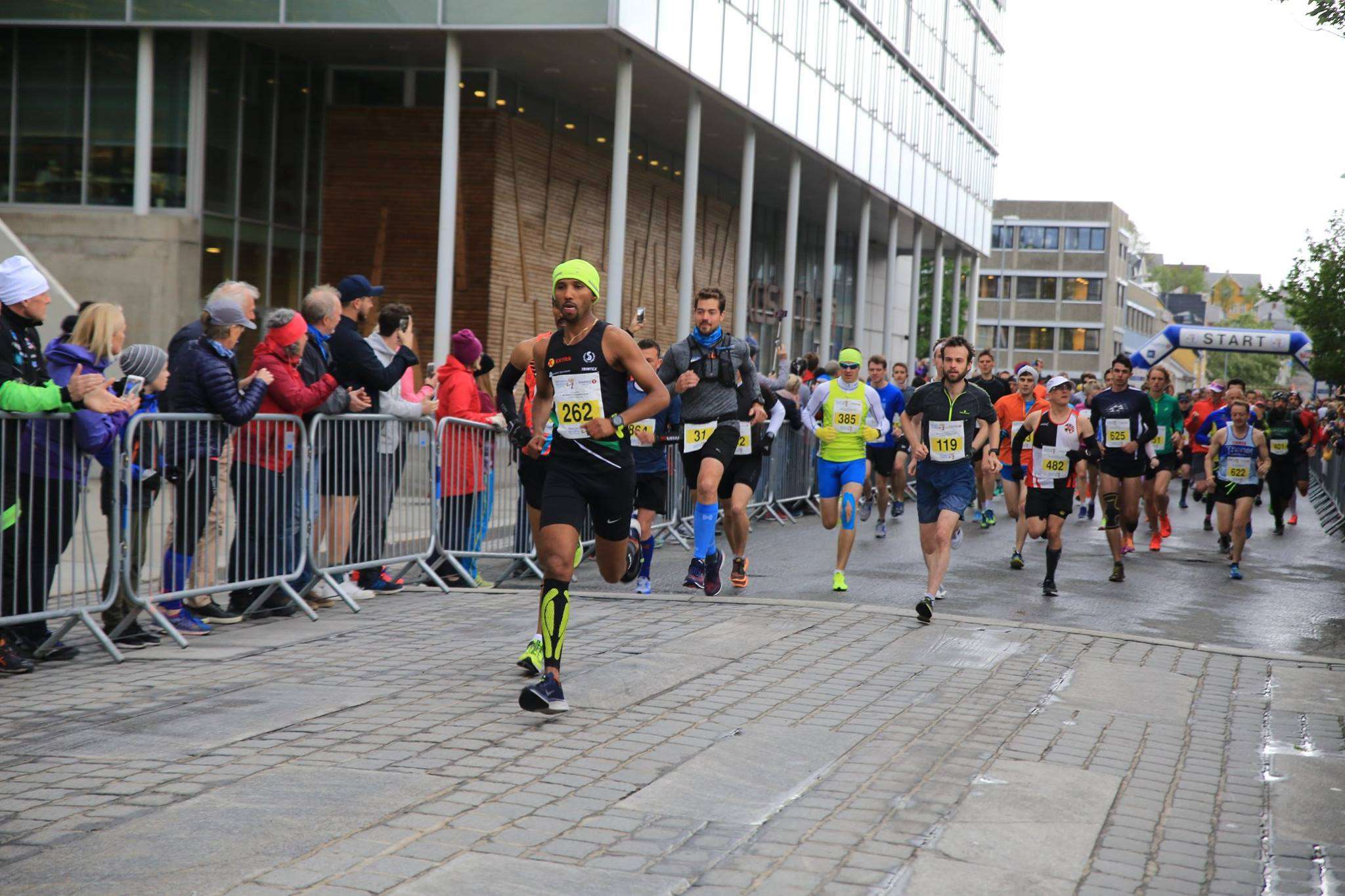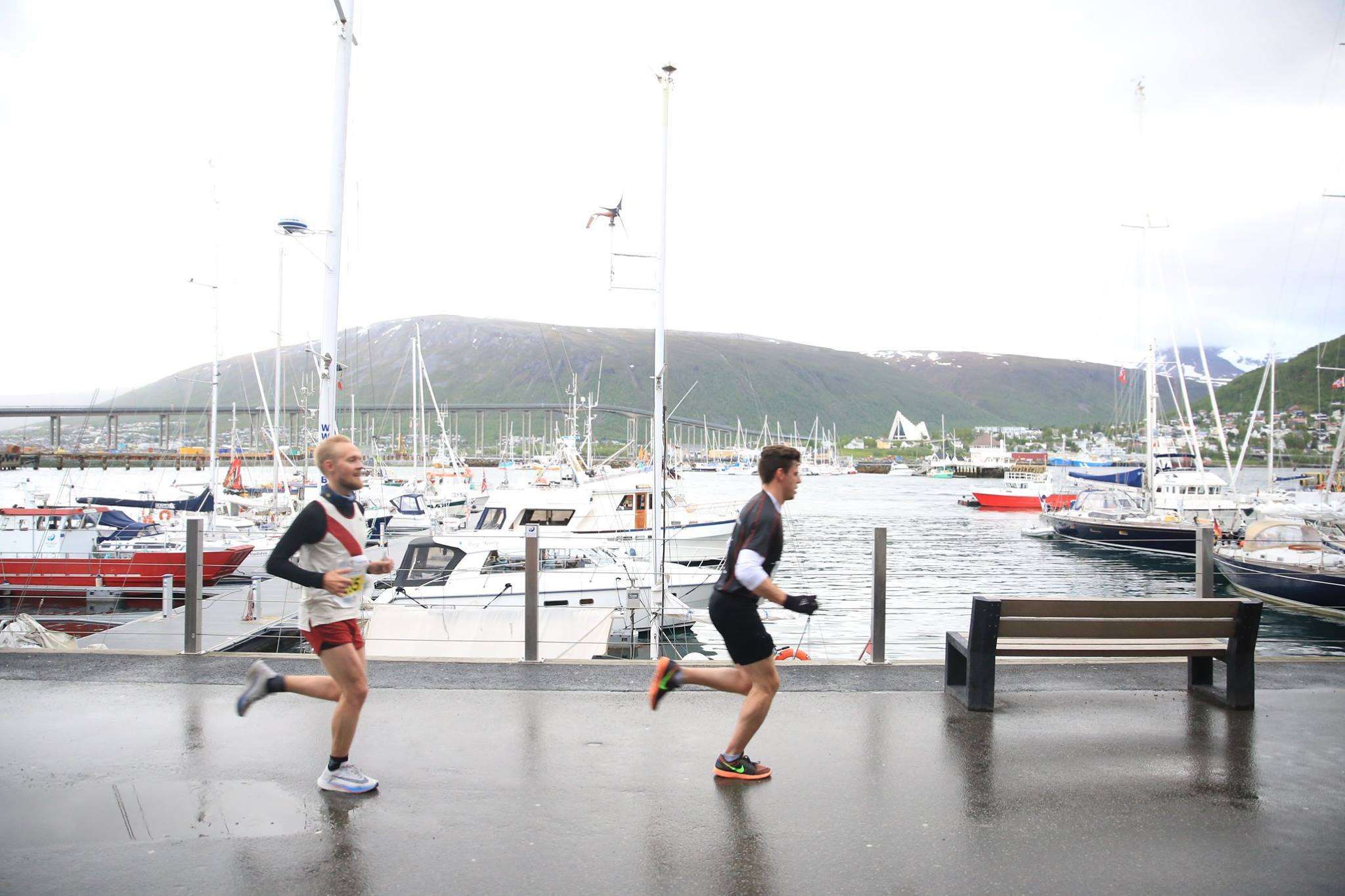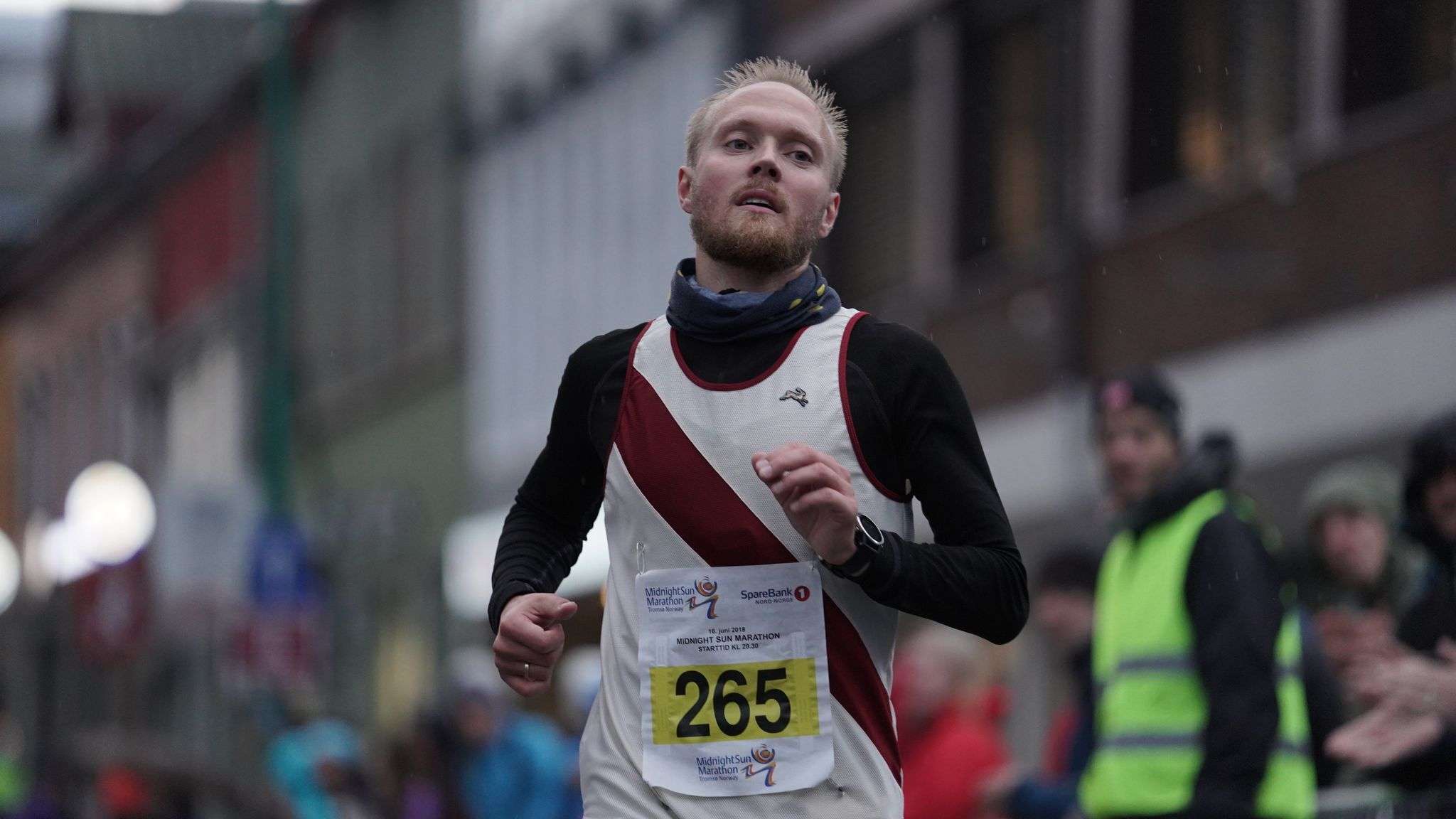Travel far enough north, and you’ll eventually reach Norway. Keep going up, and you will reach the polar circle. Go further north still, and you will find yourself firmly in the land of the midnight sun, or the night that never ends, depending on the season. But wait! You have to keep going a while yet. If you do, at long last you will reach Tromsø, a small town that hosts the world’s northernmost AIMS certified marathon.
The name of the race is Midnight Sun Marathon, but there are no guarantees issued when you sign up that the shining, yellow orb will help you through the 42 195 meters come the night of the race. I grew up around here and only emigrated south in the middle of my twenties. That is to say, I should know better than to be surprised when the forecast is showing force 5-6 winds and rain for the race. I didn’t know better, and my hopes of realising my goal of finishing my first marathon in less than three hours vanished as the wind picked up on the morning of the race.
Background and Training
In a sense, it was only fitting that the conditions for my first marathon should be less than ideal. Nothing about my journey from back when I decided to run a full marathon after my wife and I lost our baby daughter a year ago, up until this day, has felt particularly easy. Running has become my most important way of coping with seemingly bottomless grief, and every day it helps me live with a loss I still don’t understand how one is supposed to survive. As race day approached, I also decided to try and honour my daughter’s short life by sharing my story through a fundraiser. Because I am her dad, and now it is my job to try and share a little bit of the good the world was deprived of when she passed all too soon.
My background in running is limited. I started running a couple of times per week for general fitness at the end of 2016. After we lost our daughter, I started running more and averaged around 50 kilometres (30 miles) per week with a peak of 80 weekly kilometres (50 miles) leading up to a half marathon in September 2017, where I ran 1:28. I maintained that level of training leading up to a 38:31 10k a month later. After that, and a full week off, I started preparing myself to run a marathon.

From the end of October until the middle of February I had a single focus: To increase my weekly mileage. The idea was to start an 18-week plan from Pfitzinger’s Advanced Marathoning book. I knew that for sub-3 to be achievable this summer, I probably had to be able to handle the plan with 115 km (70 miles) during peak week. So I increased mileage gradually throughout the fifteen week period, doing very little else than easy running. Throughout this period, I also prioritised cross-country skiing. This change of pace and scenery, so to speak, was very important for my motivation. Even if that meant leaving some running specific fitness on the table by substituting a good few long runs for long XC skiing sessions, I think I benefitted overall.
Come the middle of February, I started the Pfitzinger plan with 115 km peak week, with an all-time weekly high mileage of 116 km going into the marathon build-up. Additionally, I had several 100+ km weeks with 30-50 km of XC skiing, so I felt prepared to handle the additional load of the workouts in the plan.
Overall, I was able to hit the prescribed paces for the workouts and long runs in the training plan without too much trouble. It was the lactate threshold sessions between 7k – 11k at around 15k race pace that I found the most challenging, but I got through them somehow. Otherwise, I started feeling generally pretty tired as soon as week 5 or 6, when the mileage got into the 100+ km/week range. But after week 6, I had two down weeks with slightly reduced mileage on account of a cold and a subsequent sinus infection. In hindsight, my body probably needed a bit of rest at that point.
Following that, I was able to go into the peak period of the training feeling decent, and I got through all of it without any particular issues. All told, I averaged around 100 km (62 miles) over the 18 weeks leading up to race day, with 112 km (70 miles) per week for the six weeks prior to starting the taper.
The consistency in my training had me feeling quite confident about my chances of a sub-3 in my marathon, as did the tune-up races I did in the lead-up. Everything lined up for me when I ran a half-marathon in 1:20:30 back in April, but upon closer examination, it turned out that the “certified” course was actually 210 meters short. Still, that should equate to a bit faster than 1:21:30, and I got further proof of my fitness when I did 36:57 for the 10k on a quite challenging course a couple of weeks later. However, I took nothing for granted. The marathon is another beast entirely, especially with the fairly undulating course of the Midnight Sun Marathon and the unpredictable conditions Northern Norway can offer up in June.

Pre-race
I flew up to Tromsø early Friday morning and stayed at a friend’s house. He’s a bit of an athlete himself, even if he doesn’t run too much with just a couple of hundred kilometres so far this year. Still, he had decided to run the full marathon too, as a gesture of support for my wife and I, and the little one we lost. We spent Friday chilling and planning out our meals for race day before we joined up with a few other friends that night for pizzas. Loads of pizzas.
The full marathon starts at 8:30 PM, which, even if I’ve known for a long time, was a bit of a curve ball for me. I prefer to do my weekend long runs straight out of bed, fasted, so I had tried to fine-tune my race day routine by seeing what worked and what didn’t on my midweek medium long runs. From those, I concluded that to minimise my chances of gastrointestinal troubles, I had to eat light and often on race day, so I stuck to white bread from when I woke up in the morning. That was, as I would learn, not enough to avoid stomach issues.
The meteorologists branded the heavy winds that hit us on Saturday morning “a typical autumn storm” and “very unusual for the season” which felt like a personal affront at that point. I did my best to place my focus elsewhere but found it difficult as it seemed everybody else had little interest in talking about anything else. Which, in fairness, is what my wife has been saying about us Northerners since she first came up to visit with me. Either way, I spent an hour before we got ready to head out to just lay in bed and focus, and felt I was able to recalibrate my expectations from focusing on a specific time to just running the best possible race given the circumstances.
In addition to the marathon, the race also has a half and a 10k, plus a couple of kids races. Both of my parents participated in the 10k, which started an hour and a half before the gun went off for the marathon. We went out to cheer them on, and it was both relaxing and motivating to see them and other people run. I was getting ready to go and met up with a buddy who would be following along on the bike and update my wife who couldn’t fly up. I ate my planned pre-race gel, and also gave my buddy a couple of extra gels, just in case.
Race
Just about a thousand people lined up to run the full –sufferfest– marathon, which was an all-time high for the race. Based on previous results, I figured I would probably finish comfortably within the top thirty, so I lined up near the front. I was ready to go, the gun went off, so I took off.

0 – 10k
The course for the full marathon is basically a double out and back from the area where we start and finish. Most of the climbing, about 230 meters (755 ft) in total, is done during the first out and back, which crosses the bridge over to the mainland. Because of this, my plan was a cautious opening, which would hopefully allow me to increase the pace in the second, and flatter half of the race. Easier said than done.
From the first step after the gun went off, I found myself feeling amazingly light on my feet. Initially, I settled behind the female lead and stayed with the group she was in as we climbed the bridge and got our first taste of the wind. It came at us sideways on the bridge, but as we came down we turned south for a 7k stretch directly into the headwind. “OK, here we go!” I thought, and I decided right then and there that I needed to stick with this group no matter how they ran until we reached the turnaround.
We quickly lost the female lead and another runner, and our group was down to three people. I felt a bit bad for letting the other two guys in the group do all the work, but they were keeping around three hour pace and I decided to be selfish and just sit behind. Through this entire stretch I felt amazing, in no small part because of my selfish drafting, I’m sure. I smiled and waved at the spectators who had defied the weather to come out and cheer us on, and I was just waiting for the turnaround to get the wind in my back and turn it on.
0 – 10k split: 42:19 (Strava)
11 – 20k
Immediately after turning around, I increased the pace, and I have never felt more comfortable with what was around 2:45 marathon pace. I kept checking my watch to make sure I wasn’t overextending, but with my heart rate sitting firmly below 170 I could only conclude that my perceived effort was probably accurate. At the start of this part of the race, I also took my first gel, planning to eat the first three in 45-minute intervals, before eating a fourth as I approached the tail end of the race.
One of the guys I had drafted behind stuck with me as I increased the pace, and we chatted a bit. This was his first marathon as well, and he too was aiming to go below three hours. I was up ahead setting the pace for the majority of this stretch, and we passed a couple of other runners who made no attempts at staying with us. At this point, I had a vague idea that we were probably in the top 20 overall, which was a bit of a stretch goal for me, based on previous years’ results.
At around 19k the rain started, and my head dropped a little. The wind hadn’t stopped me yet, but the rain made it all worse, and it was starting to cost a bit more. We were approaching the bridge again, and I knew there was a bit of climbing before the bridge as well. Here I thought I would have to let my new buddy go because I was very wary of overextending in this relatively demanding part of the course. Better to leave some time on the table, than bonking because I went to hard here.
But as my new friend set a decent pace through this part, I was able to hang on to him without overexerting, which gave me confidence leading into the second half of the race. It also just felt nice to have someone to run and chat a bit with.
11 – 20k split: 39:26 (Strava)
First half marathon split: 1:26:40 (Official)
21 – 30k
One thing I came away with after running this marathon, is that everyone should run a race in their hometown. Seeing and hearing people cheering me on throughout was an amazing feeling, and it kept me motivated when the going got tough. After my fundraiser received a bit of attention in the local press, I also got a lot of support from people I didn’t really know, and that was inspiring, too.

After passing the halfway mark, we ran through the centre of town, and I ate another gel as we headed back into the wind once more. This time it only lasted about 3k before we turned back north at the southern tip of Tromsøya, the island which holds the centre of Tromsø Town. My marathon buddy was probably feeling it a bit at this point, and he dropped in behind me when we hit the wind. I still felt alright and managed to keep us at a decent pace.
With the wind firmly in our backs again, I wanted to up the pace like I did about 15k back. But I immediately noticed that it was starting to cost a bit more to hold the pace at around 2:52 marathon pace, so I opted instead to conserve some energy. The wind that was working with us right now would soon be hitting us straight in the face yet again, and I didn’t want to spend 7k into the headwind on dead legs.
Fast approaching the 30k mark, and the time to eat my next gel, I noticed my stomach starting to act up. This has happened more than a few times, and while I thought I had it control as I went through all winter without any problems, the troubles started to reappear over the last month. Immediately, I knew that this was not something I could outrun and that I would have to stop at the next portapotty. Unfortunately, we just passed one and running another 5k didn’t really feel like an option.
21 – 30k split: 40:28 (Strava)
31 – 42k
I hoped that, against odds, the people in charge had the foresight to put up an extra portapotty at the turnaround point. My friend on the bike was still with us, and I informed him about the situation and asked if he could scout ahead and find the next one. The situation was fast becoming precarious, and I found my answer to the question “how bad do you want it?” and it was not bad enough to do a number two in my shorts.
Coming up to the turnaround, there was no portapotty, but my friend had gotten a hold of a roll of toilet paper from a car parked there. He handed it to me as I turned around, and told me to run into the bushes next to the road and get it done. Quickly! Too confused to be shy, I obliged, and around a minute later I was back to running.
Well, running might be stretching it a bit, because with the wind that hit me the moment I tried to get going again it felt like I was simply standing still. But I still had a lot to give at this point and, annoyed by my gastrointestinal troubles, I found a fresh resolve to give absolutely everything to avoid having my stomach ruin the race for me.
My chief worry at this point was that a bad bonk might be imminent because, with less than 10k to go, I had still only eaten two gels. But would my stomach handle another gel? I half made a decision by eating half a gel, and I went on. After not too long, I came back to my new buddy, with whom I’d spent more than 30k of the race with. It was clear that he was struggling at this point, as I told him to stay with me when I passed him, but he had nothing more to give.
Unfortunately for me, he would soon overtake me once more, because I only got a couple of moments of respite before my stomach started to object once more. This time, I knew that there was a portapotty just a kilometre or two up ahead, as I had spotted it when I did a shakeout run a day earlier. So I clenched up and tried to keep a decent pace. Naturally, by the time I reached the portapotty, a rush of half marathoners was running in the opposite direction, and some of them also had to use that particular portapotty. And that’s how I found myself in waiting in a line 37k into a marathon.
A couple of minutes later, I was off once more, only to find that my legs had tightened up completely. My stride was all sorts of off, and I was running stiffly, in silhouette no doubt looking 30 years older than my actual age. But this was it, and I attempted some simple calculations to figure out if finishing in less than three hours was still on the table. Relieved, I concluded that it was before I, a mere instant later, lost all faith in my ability to perform even the simplest arithmetic. Panicked that I wouldn’t make it, I tried to up the pace a bit again, and I do believe it lasted all of a hundred meters before I slowed again.

Worse still, I could feel my stomach starting to cramp up, which just a couple of weeks ago, during my final hard long run, forced me to a walking pace as I struggled to breathe. But I passed the 2k to go marker, and I was adamant that nothing was going to stop me now. I kept repeating the name of our daughter like a chant, calling on her to help me keep going. And somewhere behind me, I heard my friend on the bike, too, shouting to me that I just had to keep going, we had this. Somewhere around here, I also passed my race buddy once more, but I have only a vague recollection of it. Suffice to say, he was really struggling at this point.
After what seemed like the longest thousand meters I ever ran, I eventually reached the marker that said 1k to go, and I looked at my watch and knew that finishing under three hours was in the bag. One final push, through the crowded main street of Tromsø, and my parents came into view at the finish line. It wasn’t pretty, but I had done it. On the eve of the first anniversary of our little girl’s passing, I had run a sub-3 marathon. For me, and for her.
31 – 40k split: 44:54 (Strava)
Second half marathon split: 1:31:49 (Official)
Official finish time: 2:58:29
Post-race
My parents both embraced me at the finish line, and it was a very emotional moment. I couldn’t really stand upright for the first couple of minutes, I was just so exhausted. Not just from running, but from a full year of trying to find a way to give meaning to a life without my baby girl.
A couple of reporters were waiting for me to get up, and wanted to talk about the race, our story and the fundraiser. Words didn’t come easy at this point, and I think I only spoke in a malaise of sobs and half sentences. I did, however, manage to utter how overwhelmed I was with the outcome of the fundraiser. While starting it, I had hoped to race around $1 000. By the time it ended, people had donated more than $10 000.
I was also very happy to see just that my new racing buddy crossed the finish line just a small minute after me, which meant that he was also able to reach his goal of going sub-3. With all the commotion I never got to properly thank him for working together, but he gave me a light tap on the shoulder before he disappeared, hopefully off to celebrate.
What’s next?
This week is all about rest and recovery. Physically I am shot, especially my quads and my right calf, but mentally I am just absolutely drained. So no running for a week, before I plan on starting up again with nothing more than easy running for a couple of weeks.
Another marathon is not really tempting at this moment, but I want to keep going and eventually give it another go to see if I can come closer to realising my potential in terms of finishing time. In the coming weeks, I will be seeking medical advice to find out if there’s anything I can do to alleviate the stomach problems which have plagued me for a while now. I imagine I will be spending the rest of the year trying to figure that out, and if I do, perhaps a spring marathon is realistic. Either way, Berlin 2019 in the fall is the big one that has been in the back of my mind for some time now already.
In terms of the second half of this year, I am hoping to further improve my PRs in the 5k, 10k and in the half marathon. I think sub-17:30, sub-36 and sub-1:20 could be realistic, and I’m ready to try for all three. But, we’re also welcoming a little brother into our family towards the end of August, so we’ll so how much that will affect my training. I can already barely wait until he’s old enough to bring along in a jogging stroller. For some reason, I feel like that will not only bring him closer to me but to a sister he never got to meet as well.
For all the detailed data from the race, check the Strava activity.
Like this?
Let me know by sending me an email at lc@run161.com.
